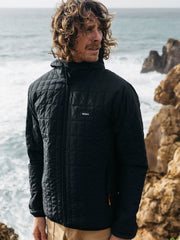We recently journeyed to the Shetland Islands, discovering a rich heritage of maritime and crafting history. We were intrigued by stories of women of the herring boom of the late 19th century and their part in fishing history.
When The Boat Comes In | Fishing Women And Herring Girls
09.08.17
4 min read
Written by Rachel Buchanan
The Shetland Islands. Suspended between the Atlantic and Scandinavia, these wild islands have a rich maritime heritage; during the herring boom of the late 1800s and early 1900s Shetland dominated European fisheries.
For the women of Shetland, the herring boom brought unexpected freedom: a source of individual income, and for those “herring girls” that followed the migratory route of the herring from Shetland down the east coast of England, independence.
Paid by the barrel for gutting, salting and packing the fish, it was hard, fast paced work but still offered something more than domestic duties. They worked closely together, often 6 days a week, in close-knit teams of three; two to gut, one to size, sort, pack and salt the fish in the barrels. Salt rubbed in wounds not just hurt but reduced speed so the women took to wrapping their fingers in bandages fashioned from scraps of flour sacks. This was not work for the feint-hearted but these were stoic, practical women.
And while they waited for the fish to land, the women knitted. Each fisherman needed up to seven garments, provided by their womenfolk. These traditional fishing guernseys or ganseys were practical, heavy weight and densely woven, designed to keep out wind and rain.
Knitted outside to get the best light using fine steel needles, each woman would have a knitting belt to assist with the weight of the garment. Sleeves would be in a plain stocking stitch so that they were easily replaced, but the bodies would be more intricate with unique patterns and stitches. Some of the stitches represented the village where the men were based, to allow easy recognition should the worst happen, but other lines represented marriage, children and other personal signifiers. These may have been practical jumpers but they were knitted with love and dedication, each stitch meaningful. They didn't just keep the fishermen warm; they were a story.
They were also an evolving work of art; there were no patterns. Family history and knowledge was passed down the generations by watching and learning. Young girls were knitting before they were 5, helping with the cuffs and other lighter parts of the garment, learning the family patterns. Previously each village would have had no outside influence but this all changed once the herring girls followed the fish; Former herring girls are said to have reminisced about rivalry and one-up-man-ship of using patterns that no-one else in the village was using.
The work of the herring girls came to a gradual end with the Second World War but despite the popularity of the domestic knitting machine, traditional knitting techniques have never quite been forgotten and the guernsey lives on.
It is this passion and dedication which inspired us to create our latest knitwear collection.


















































































